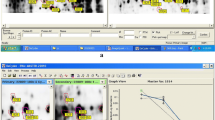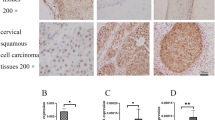Abstract
Background
Cervical cancer (CC) is a common malignancy in women worldwide. Cervical tumorigenesis involves a multistep process in which accumulations of genetic alterations are present. Homeotic genes, such as HOX gene re-expression, have been reported in a wide variety of tumors.
Methods
In order to know the role of HOX B4 gene expression in CC, in the present study, two-dimensional polyacrylamide gel electrophoresis, matrix-assisted laser desorption/ionization, and time-of-flight mass spectrometry were used for differential screening of protein expression in CC. Immunohistochemical analysis was performed on the cervical tissue microarray (TMA) to detect the Hox B4 protein.
Results
Hox B4 peptide was detected among 15 increased spots differentially observed in CC. Using TMA, Hox B4 protein was also immunodetected in the nuclei of cervical epithelial tumor cells, while in normal cervical epithelium, it was absent. Interestingly, it was possible to detect the Hox B4 protein in the precursor lesions.
Conclusions
Hox B4 protein is present in the precursor lesions as CC cells, suggesting that Hox B4 could be a protein related to the neoplastic state (non-differentiated cells) of human cervical epithelium.


Similar content being viewed by others
References
Abate-Shen C (2002) Deregulated homeobox gene expression in cancer: cause or consequence? Nat Rev Cancer 2:777–785
Adam BL, Vlahov A, Semmes OJ, Wright GLJ (2001) Proteomic approaches to biomarker discovery in prostate and bladder cancers. Proteomics 1:1264–1270
Antochuk J, Sauvageaun G, Humphries RK (2001) HOXB4 overexpression mediates very rapid stem cell regeneration and competitive hematopoietic repopulation. Exp Hematol 29:1125–1134
Argiropoulos B, Humphries RK (2007) Hox genes in hematopoiesis and leukemogenesis. Oncogene 26:6766–6776
Bae SM, Lee CH, Cho YL, Nam KH, Kim YW, Kim CK, Han BD, Lee YJ, Chun HJ, Ahn WS (2005a) Two-dimensional gel analysis of protein expression profile in squamous cervical cancer patients. Gynecol Oncol 99:26–35
Bae SM, Lee CH, Cho YL, Nam KH, Kim YW, Kim CK, Han BD, Lee YJ, Chun HJ, Ahn WS (2005b) Two-dimensional gel analysis of protein expression profile in squamous cervical cancer patients. Gynecol Oncol 1:26–35
Barba de la Rosa AP, Lugo-Melchor OY, Briones-Cerecero EP, Santos L, DeLeón-Rodríguez A, Chagolla-Lopez A, Salcedo M (2008) Two-dimensional analysis of human serum from women with and without cervical lesions. J Exp Ther Oncol 7:65–72
Berumen J, Casas L, Segura T, Amezcua JL (1994) García-Carrancá. Genome amplification of the human papillomavirus types 16 and 18 in cervical carcinomas is related to the retention of E1/E2 genes. Int J Cancer 1:640–645
Berumen J, Ordonez RM, Lazcano E, Salmeron J, Galvan SC, Estrada RA, Yunes E, Garcia-Carranca A, Madrigal-de la Campa A (2001) Asian–American variants of human papillomavirus 16 and risk for cervical cancer: a case–control study. J Natl Cancer Inst 93:1325–2330
Bodey B, Bodey B Jr, Siegel SE, Kaiser HE (2000) Immunocytochemical detection of the homeobox B3, B4 and C6 gene products in breast carcinomas. Anticancer Res 20(5A):3281–3286
Cantile M, Franco R, Tschan A, Baumhoer D, Zoblec I, Schiavo G et al (2009) HOXD13 expression across 79 tumor tissue types. Int J Cancer 125:1532–1541
Cho GW, Shin SM, Namkoong H, Kim HK, Ha SA, Hur SY, Kim TE, Chai YG, Kim JW (2006) The phosphatidylinositol 3-kinase/Akt pathway regulates the HCCR-1 oncogene expression. Gene 384:18–26
Cho GW, Shin SM, Kim HK, Ha SA, Kim S, Yoon JH, Hur SY, Kim TE, Kim JW (2007) HCCR-1, a novel oncogene, encodes a mitochondrial outer membrane protein and suppresses the UVC-induced apoptosis. BMC Cell Biol 28(8):50
Choi YP, Kang S, Hong S, Xie X, Cho NT (2005) Proteomic analysis of progressive factors in uterine cervical cancer. Proteomics 5:1481–1493
Dzul RK, Puerto SM, González LM (2004) Cáncer cervicouterino: métodos actuales para su detección. Rev Biom 15:233–241
Franco L, Franco DE, Terenzy A (2001) Cervical cancer: epidemiology prevention and the role of human papillomavirus infection. CMAI 164:1017–1025
Grier DG, Thompson A, Kwasniewska A, McGonigle GJ, Halliday HL, Lappin TR (2005) The pathophysiology of HOX genes and their role in cancer. J Pathol 205:154–171
Gu Y, Wu SL, Meyer JL, Hancock WS, Burg LJ, Linder J, Hanlon DW, Karger BL (2007) Proteomic analysis of high-grade dysplastic cervical cells obtained from ThinPrep slides using laser capture microdissection and mass spectrometry. J Proteome Res 11:4256–4268
Hidalgo A, Baudis M, Petersen I, Arreola H, Piña P, Vázquez G, Hernández D, González J, Lazos M, López R, Pérez C, García J, Vázquez K, Alatorre B, Salcedo M (2005) Microarray comparative genomic hybridization detection of chromosomal imbalances in uterine cervix carcinoma. BMC Cancer 9:77
Jones BM, Krutzsh H, Shu H, Zhao Y, Liotta LA, Kohn EC, Petricoin EF (2002) Proteomic analysis and identification of new biomarkers and therapeutic targets for invasive ovarian cancer. Proteomics 2:76–84
Ko J, Lee YH, Hwang SY, Lee YS, Shin SM, Hwang JH, Kim J, Kim YW, Jang SW, Ryoo ZY, Kim IK, Namkoong SE, Kim JW (2003) Identification and differential expression of novel human cervical cancer oncogene HCCR-2 in human cancers and its involvement in p53 stabilization. Oncogene 22:4679–4689
Krosl J, Asutin P, Beslu N et al (2003) In vitro expansion of hematopoietic stem cell by recombinant TAT-HOXB4 protein. Nat Med 9:1428–1432
Lee KH, Yim EK, Kim CJ, Namkoong SE, Um SJ, Park JS (2005) Proteomic analysis of anti-cancer effects by paclitaxel treatment in cervical cancer cells. Gynecol Oncol 98:45–53
Li Z, Huang C, Bai S, Pan X, Zhou R, Wei Y, Zhao X (2008) Prognostic evaluation of epidermal fatty acid-binding protein and calcyphosine, two proteins implicated in endometrial cancer using a proteomic approach. Int J Cancer 123:2377–2383
Lin YW, Lai HC, Lin CY, Chiou JY, Shui HA, Chang CC, Yu MH, Chu TY (2006) Plasma proteomic profiling for detecting and differentiating in situ and invasive carcinomas of the uterine cervix. Int J Gynecol Cancer 16:1216–1224
Lopez R, Garrido E, Piña P, Hidalgo A, Lazos M, Ochoa R, Salcedo M (2006) HOXB homeobox gene expression in cervical carcinoma. Int J Gynecol Cancer 16:329–335
López R, Garrido E, Vázquez G, Piña P, Pérez C, Alvarado I, Salcedo M (2006) A subgroup of HOX Abd-B gene is differentially expressed in cervical cancer. Int J Gynecol Cancer 16:1289–1296
Meehan KL, Holland JW, Dawkins HJS (2002) Proteomic analysis of normal and malignant prostate tissue to identify novel proteins lost in cancer. Prostate 50:54–63
Morgan EA, Forootan SS, Adamson J, Foster CS, Fujii H, Igarashi M, Beesley C, Smith PH, Ke Y (2008) Expression of cutaneous fatty acid-binding protein (C-FABP) in prostate cancer: potential prognostic marker and target for tumourigenicity-suppression. Int J Oncol 32:767–775
Paavonen J (2007) Human papillomavirus infection and the development of cervical cancer and related genital neoplasias. Int J Infect Dis 11(Suppl 2):S3–S9
Parkin DM, Bray F, Ferlay J, Pisani P (2005) Global cancer statistics, 2002. CA Cancer J Clin 55:74–108
Perez-Plasencia C, Riggins G, Vázquez-Ortiz G, Moreno J, Arreola H, Hidalgo A, Piña-Sanchez P, Salcedo M (2005) Characterization of the global profile of genes expressed in cervical epithelium by serial analysis of gene expression (SAGE). BMC Genomics 19:130
Petricoin EF III, Ardekani AM, Hitt BA, Levine PJ, Fusaro VA, Steinberg SM, Mills GB, Simone Ch, Fishman DA, Kohn EC, Liotta LA (2002) Use of proteomic patterns in serum to identify ovarian cancer. Lancet 359:572–577
Piña-Sanchez P, Hernández-Hernández DM, López-Romero R, Vázquez-Ortíz G, Pérez-Plascencia C, Lizano-Soberón M, González-Sánchez JL, Cruz-Talonia F, Salcedo M (2006) Human papillomavirus-specific viral types are common in Mexican women affected by cervical lesions. Int J Gynecol Cancer 16:1–7
Sauvageau G, Landsdorp PM, Eaves CJ et al (1994) Differential expression of homeobox genes in functionally distinct CD34+ subpopulations of human bone marrow cells. Proc Natl Acad Sci USA. 12223–12227
Seow TK, Liang RC, Leow CK, Chung MC (2001) Hepatocellular carcinoma: from bedside to proteomics. Proteomics 1:1249–1263
Somiari RI, Somiar S, Russell S, Shriver CD (2005) Proteomics of breast carcinoma. J Chromatograph B 18:215–255
Suomela S, Elomaa O, Asumalahti K, Kariniemi AL, Karvonen SL, Peltonen J, Kere J, Saarialho-Kere U (2003) HCR, a candidate gene for psoriasis, is expressed differently in psoriasis and other hyperproliferative skin disorders and is downregulated by interferon-gamma in keratinocytes. J Investigative Dermatol 121:1360–1364
Tang LJ, De Seta F, Odreman F, Venge P, Piva C, Guaschino S, Garcia RC (2007) Proteomic analysis of human cervical–vaginal fluids. J Proteome Res 6:2874–2883
Uma RS, Naresh KN, D’Cruz AK, Mulherkar R, Borges AM (2007) Metastasis of squamous cell carcinoma of the oral tongue is associated with down-regulation of epidermal fatty acid binding protein (E-FABP). Oral Oncol 43:27–32
Walboomers JM, Jacobs MV, Manos MM, Bosch FX, Kumme JA, Shan KU, Snijders FJ, Peto J, Meijer CJL, Muñoz N (1999) Human papillomavirus is a necessary cause of invasive cervical cancer worldwide. J Pathol 189:12–19
WIPO (2006) Intellectual property organization. http://www.wipo.int/patentscope/search/en/WO2001027149
Wu W, Hu W, Kavanagh JJ (2002) Proteomics in cancer research. Int J Gynecol Cancer 12:409–423
Zhai Y, Kuick R, Nan B, Ota I, Weiss SJ, Trimble CL, Fearon ER, Cho KR (2007) Gene expression analysis of preinvasive and invasive cervical squamous cell carcinomas identifies HOXC10 as a key mediator of invasion. Cancer Res 21:10163–10172
Zhang X, Schwartz J, Humphries R, Kiem H (2007) Effects of HOXB4 overexpression on ex vivo expansion and immortalization of hematopoietic cells from different species. Stem Cells 25:2074–2081
Acknowledgments
This work was partially supported by the Fondos Mixtos Guanajuato and San Luis Potosí, Mexico, and Fondos Sectoriales 87244 and 69719 CONACYT, Mexico. We thank Dra. Sara Fonseca Castañol for her invaluable help on this work.
Author information
Authors and Affiliations
Corresponding author
Rights and permissions
About this article
Cite this article
Barba-de la Rosa, A.P., Briones-Cerecero, E., Lugo-Melchor, O. et al. Hox B4 as potential marker of non-differentiated cells in human cervical cancer cells. J Cancer Res Clin Oncol 138, 293–300 (2012). https://doi.org/10.1007/s00432-011-1081-2
Received:
Accepted:
Published:
Issue Date:
DOI: https://doi.org/10.1007/s00432-011-1081-2




